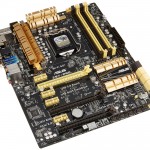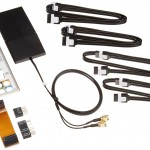Where other motherboard manufacturers have opted for more desktop established technologies, Asus, with its Z87-Pro range, has instead gone down the modernist route and included the ability to connect your PC to your phone or tablet. It’s not a bad idea, but it can be a little niche.
This is an ATX board that supports Intel’s fourth-generation Haswell processors and offers eight SATA 6Gbps ports (six on the Z87 chipset and a further two through the ASMedia ASM 1061 controller), four USB 3.0 ports with the Z87 chipset and another four through the ASMedia controller, four DIMM DDR3 slots for a maximum of 32GB at 3000MHZ (overclocked) and 4K UHD integrated graphics.
The SLI/CrossFire support comes in the form of two PCIe 3.0 16x slots, one PCIe 2.0 16x slot and four PCIe lx slots. As expected, the two PCle 3.0 slots run at 8x if two graphics cards are fitted and at full 16x provided only one is present, with the third PCIe 2.0 graphics slot running at 4x. Interestingly, there’s no legacy PCI slot on this board, which does offer a tad more room when fitting a third card, although not by a huge amount.
Fitting three R9 280s was easy enough, since they’re pretty big cards, and there was enough of a gap for decent air flow throughout the system and between the cards. It’s worth noting, though, that there wasn’t as much room as with the MSI board, but more than the ASRock and Gigabyte boards.
The emphasis on a modern approach doesn’t just finish the absence of a legacy PCI slot. This board has on it a Wi-Fi GO! card, which is a dual-band device that can handle 802.11 a/b/g/n 2.4 and 5GHz frequencies and Bluetooth connectivity, both V3.O and V4.O. You’ll also get an Asus dual-band 2T2R antenna in the box and full instructions on how to setup a wi-fi hotspot.
The Asus UEFI offers a far better graphical setup than most of the other boards on test. There’s an EZ mode, which allows you to quickly get to the most used and important features of the board and alter settings such as the fan speed, temperature, time and date. And an Advanced mode offers greater control of the board’s features and opens up the overclocking potential in a more traditional-looking BIOS environment.
The design of the board is rather exceptional looking. With a black PCB and yellow connectors and slots, complete with gold heatsinks and stylized Asus logos throughout, it’s certainly very eye-catching and would be excellent for an open-view system. But although it looks splendid, we did find it to be a little cheap feeling when compared to the other boards we’d already tested. It works perfectly well, but there was a little too much flex and a couple of the PCI ports were raised slightly on their connections. Plus the locking clip on the CPU socket felt as if it would break off without too much difficulty.
Having said that, this is still a good board, which it should be, since it costs just shy of $170. But we would expect a little better quality and more care for the extra dollars.
[amzn_product_inline asin=’B00CRJSXR4′]



